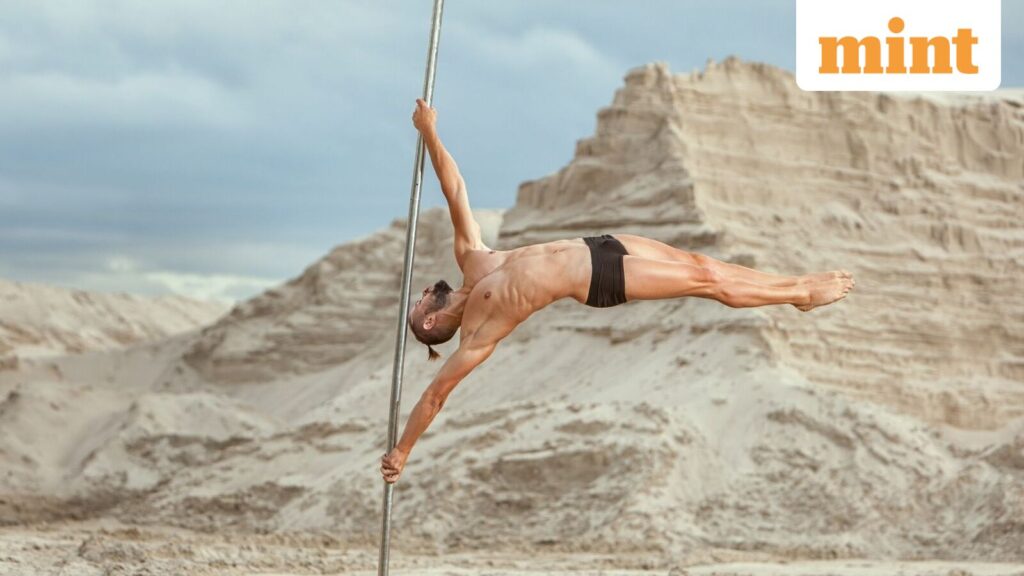One of the most advanced isometric holds is the human flag. There are only two others which are more advanced—the front lever and the front planche. While both of those need coaching, training, and advanced levels of control and strength, the human flag can still be within reach for intermediate fitness enthusiasts. It’s also more fun, has fewer levels of progression, and doesn’t need to be held longer than a few seconds to give one the sense of gaining a big achievement.
But that doesn’t make it any easier. A minimum of six months of training until a full human flag is recommended. But it can take up to over a year as well, depending on how much work you put in not just on training for this move, but also the other exercises which help make the human flag easy. If you’re looking for something simpler, then try learning the back lever first, with a detailed progression plan in an earlier article I wrote for Lounge titled, Master the Back Lever: The exercise that gymnasts use to build superhuman core and shoulder strength.
When done right, this is what the human flag looks like: the body extended and elevated sideways with the only body contact being the arms gripping an upright pole or a calisthenics ladder. “This challenging exercise develops extraordinary core power, grip strength, and full-body coordination while building mental resilience. Training for this iconic move transforms your physique, enhances functional strength, and demonstrates remarkable athletic achievement that showcases years of dedicated practice and determination,” states an Indian School of Calisthenics article titled Know the Human Flag Exercise : A Calisthenics Masterpiece. So it’s more than just a show-off move. This is an ode to your prowess and has incredible benefits as well.
The Indian School of Calisthenics possibly has the best timetable for learning this move. It would be clever to take a screenshot of this and follow it, not only to master the human flag, but also to learn every foundational move that could help your isometric and dynamic moves. And yes, these include lifts.
View Full Image
Timetable for mastering the Human Flag. (Courtesy Indian School of Calisthenics)
Pull-ups, push-ups, planks, and L-sits are self-explanatory. But here’s a more detailed breakdown of some of the moves mentioned above. The muscle-up seems to be the most challenging of the progressions. This is when you use momentum on a pull-up bar to pull yourself up the bar as if you are climbing over a wall which is too high, or maybe off the edge of a swimming pool to come out, and then go back to the starting point.
There is a more detailed progression to learning this in a piece I wrote for Lounge in 2022, titled Take your strength to the next level with the muscle-up. One has to learn to kill the momentum in this exercise over time, and the course work above gives this level the most time, with 12-16 weeks of practice.
The muscle-up teaches opposing forces and increases deltoid strength. Understanding opposing forces is pivotal for learning the human flag given how both your sides in the upper body (the lats, the shoulders and the grip) will be keeping the body in an isometric hold pushing and pulling towards each other.
There is one set of muscles which goes a little under the radar. These are the obliques. So anything and everything which works them should be done. These include side plank holds on the floor, corkscrew raises on the dip machine and windshield wipers on the floor and then while hanging. This will help you with the first progression to the human flag on the calisthenics ladder. To mimic this, hold onto the bars in human flag style and do a side plank with the feet on the floor. Then raise one leg and hold. Step two would be to kick the feet into the air in a side plank and tap them.
A few reps of these every day should be enough to tell you the stability needed in the shoulders. Be patient with these and let the body understand the intricacies of the control required. Make sure the lats and shoulders and more importantly, the core, is taking the load while you use momentum and force to fight gravity.
Gymless Fitness has the best video on this with every exercise explained and demonstrated. When I learned the human flag, which I haven’t done in a few years (more due to lack of a calisthenics ladder than anything else), I skipped the inverted tuck holds and went straight into a straddle human flag. The straddle is a key element of progression in any move which requires the feet to be kept together, because this is the move in which the rules are not that strict. It means one can do the flag with the feet spread apart. Then comes the one leg straddle which allows you to tuck the knee on one side and open the other and then slowly reach a point where you can execute a full human flag.
There are many steps to getting to the final move, but the road is long and the steps are many. But consider this a maze with no dead ends. Even if you stop at any level, the game continues from there. But be consistent, because to execute a human flag for even three seconds is more than what 95% of people can do. And the end of it all, you will have learnt at least a dozen holds and dynamic moves and gained control, stability and strength in the shoulders, lats and core unlike any other calisthenics move.
Pulasta Dhar is a football commentator and writer.

